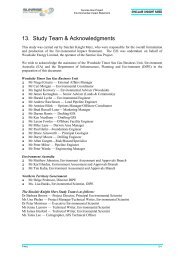Appendix D Terrestrial and Aquatic Biodiversity - Environment ...
Appendix D Terrestrial and Aquatic Biodiversity - Environment ...
Appendix D Terrestrial and Aquatic Biodiversity - Environment ...
You also want an ePaper? Increase the reach of your titles
YUMPU automatically turns print PDFs into web optimized ePapers that Google loves.
Birds<br />
• One Data Deficient species, Antaresia childreni, <strong>and</strong> one Not Evaluated species, Cryptoblepharus<br />
ruber, were identified. These are both common <strong>and</strong> widespread in suitable habitat throughout<br />
northern Australia. The status of Antaresia childreni is proposed to be changed to Least Concern.<br />
• The remaining species are all listed as Least Concern.<br />
• One listed marine species – Freshwater Crocodile (Crocodylus johnstoni) – was recorded.<br />
• No introduced reptile species were identified.<br />
A total of 91 bird species from 47 families was identified during the survey (<strong>Appendix</strong> D-2). Very few<br />
waterbirds <strong>and</strong> waders (shorebirds) were recorded, reflecting the paucity of permanent water within the MLA<br />
areas <strong>and</strong> that there are ample areas of habitat offsite, such as the Towns <strong>and</strong> Little Towns Rivers.<br />
• Two threatened species were recorded:<br />
o Emu (Dromaius novaeholl<strong>and</strong>iae) is listed as Vulnerable <strong>and</strong> was recorded at Site 7.<br />
Widespread across Australia, there is poorly quantified evidence to suggest this species has<br />
experienced a population reduction in the north of its range (because of altered fire regimes.<br />
A proposed review of the NT Threatened Species List downgrades the Emu’s status to Near<br />
Threatened.<br />
o Australian Bustard (Ardeotis australis) is also listed at Vulnerable <strong>and</strong> was recorded at Sites<br />
2, 4 <strong>and</strong> 6, as well as incidentally. As with the Emu, with whom the Australian Bustard<br />
shares a similar distribution <strong>and</strong> ecology, the claimed population reduction of this species is<br />
questionable, hence its status is earmarked to be reduced to Least Concern.<br />
• One Near Threatened species, Bush Stone-curlew (Burhinus grallarius), was recorded at a number<br />
of different sites, as well as incidentally. This species is common <strong>and</strong> widespread in suitable fox-free<br />
habitat throughout northern Australia.<br />
• Three Data Deficient species were recorded – Black Bittern (Ixobrychus flavicollis), Blue-winged<br />
Kookaburra (Dacelo leachii), <strong>and</strong> a Snipe (Gallinago species – not possible to identify except if in the<br />
h<strong>and</strong>), as was a Not Evaluated species– White-throated Needletail (Hirundapus caudacutus). The<br />
statuses for both Black Bittern (Ixobrychus flavicollis) <strong>and</strong> Blue-winged Kookaburra (Dacelo leachii)<br />
are proposed to be revised to Least Concern.<br />
• The remaining species are all listed as Least Concern.<br />
• Four listed migratory species <strong>and</strong> 23 listed marine species were observed, all are common <strong>and</strong><br />
widespread throughout the savannah.<br />
• No introduced bird species were recorded.<br />
Mammals<br />
Eleven mammal species were recorded from the survey, mainly from pit traps, Elliot traps <strong>and</strong> active<br />
searches (<strong>Appendix</strong> D-2). In addition, seven species of bat were captured or identified acoustically (see<br />
<strong>Appendix</strong> D-5). The total number of mammal species, therefore, was 19. All bar one bat species were<br />
recorded on multiple occasions. Aside from bat species, only the Common Rock-rat (Zyzomys argurus) was<br />
recorded with any regularity – occurring at four separate sites, all of which were rocky habitats within the<br />
eastern MLA areas targeted for ore extraction. Two macropod species were recorded, but with only a total of<br />
three sightings, suggesting a low abundance.<br />
• No threatened species were recorded.<br />
• Two Near Threatened species were recorded – Orange Leaf-nosed Bat (Rhinonicteris aurantia) at<br />
riparian Site 11 <strong>and</strong> Western Chestnut Mouse (Pseudomys nanus) at Site 14.<br />
Client: Western Desert Resources Ltd Page 73 of 150<br />
Doc No. DW120004-C0302-EIA-R-0036<br />
Doc Title: <strong>Appendix</strong> D – <strong>Terrestrial</strong> <strong>Biodiversity</strong> Technical Report



